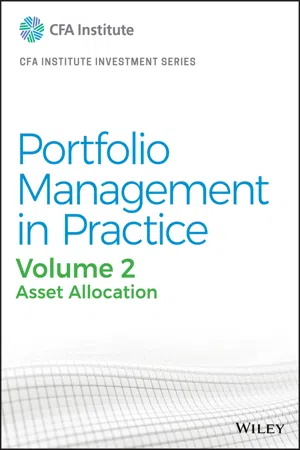
Portfolio Management in Practice, Volume 2
Asset Allocation
- English
- ePUB (mobile friendly)
- Available on iOS & Android
Portfolio Management in Practice, Volume 2
Asset Allocation
About This Book
Discover the latest essential resource on asset allocation for students and investment professionals.
Part of the CFA Institute's three-volume Portfolio Management in Practice series, Asset Allocation offers a deep, comprehensive treatment of the asset allocation process and the underlying theories and markets that support it. As the second volume in the series, Asset Allocation meets the needs of both graduate-level students focused on finance and industry professionals looking to become more dynamic investors.
Filled with the insights and industry knowledge of the CFA Institute's subject matter experts, Asset Allocation effectively blends theory and practice while helping the reader expand their skillsets in key areas of interest.
This volume provides complete coverage on the following topics:
- Setting capital market expectations to support the asset allocation process
- Principles and processes in the asset allocation process, including handling ESG-integration and client-specific constraints
- Allocation beyond the traditional asset classes to include allocation to alternative investments
- The role of exchange-traded funds can play in implementing investment strategies
- An integrative case study in portfolio management involving a university endowment
To further enhance your understanding of tools and techniques explored in Asset Allocation, don't forget to pick up the Portfolio Management in Practice, Volume 2: Asset Allocation Workbook. The workbook is the perfect companion resource containing learning outcomes, summary overview sections, and challenging practice questions that align chapter-by-chapter with the main text.
Frequently asked questions
Information
CHAPTER 1
BASICS OF PORTFOLIO PLANNING AND CONSTRUCTION
LEARNING OUTCOMES
- describe the reasons for a written investment policy statement (IPS);
- describe the major components of an IPS;
- describe risk and return objectives and how they may be developed for a client;
- distinguish between the willingness and the ability (capacity) to take risk in analyzing an investor’s financial risk tolerance;
- describe the investment constraints of liquidity, time horizon, tax concerns, legal and regulatory factors, and unique circumstances and their implications for the choice of portfolio assets;
- explain the specification of asset classes in relation to asset allocation;
- describe the principles of portfolio construction and the role of asset allocation in relation to the IPS;
- describe how environmental, social, and governance (ESG) considerations may be integrated into portfolio planning and construction.